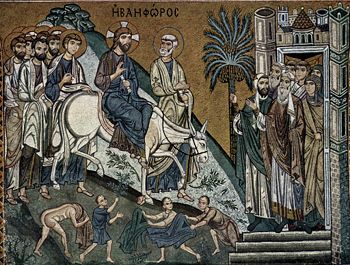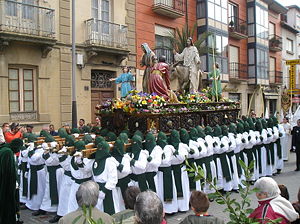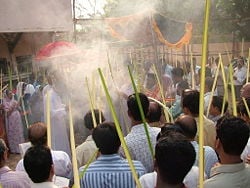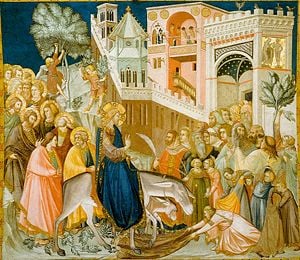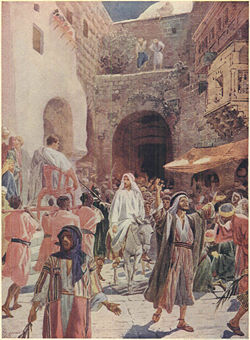Palm Sunday
Palm Sunday is a Christian feast day which falls on the Sunday before Easter. It commemorates the triumphal entry of Jesus into Jerusalem in the days before his Passion, during which his supporters greeted him as the coming Messiah. The Gospel of John specifies that the crowd waved palm branches in greeting, declaring: "They took branches of palm trees and went out to meet him, shouting, ‘Hosanna! Blessed is the one who comes in the name of the Lord—the King of Israel!.’" (John: 12:12)
The holiday is celebrated with processions in which Christians carry palm leaves or branches and hear sermons concerning Jesus' entry into Jerusalem. "Passion Sunday" and similar terms are also used to designate the day. The difficulty of procuring palms for that day's ceremonies in unfavorable climates has led to the substitution of boughs of yew, willow, or other native trees in some areas.
Recent studies have offered new interpretations of the events commemorated on Palm Sunday, and even the day on which the events occurred has been called into question. His triumphal entry may have been seen by the people of his day as a declaration that he had come to fulfill the traditional prophecies about the Jewish Messiah. It is a matter of debate as to whether Jesus himself thought of this act as the major step toward his acceptance, or an intentional precursor to his death on the Cross.
In the New Testament
The events commemorated by Palm Sunday are reported by all four canonical Gospels: Mark 11:1-11, Matthew 21:1-11, Luke 19:28-44, and John 12:12-19. In these passages, before entering Jerusalem, Jesus was staying at Bethany and Bethphage. While there, he is described by the synoptic Gospels as sending two unnamed disciples to a nearby village to retrieve a donkey's colt that had been tethered there but never been ridden. They were instructed to say, if questioned, that the colt was needed by the Lord but would be returned in a short period of time.
The Gospels state that Jesus then rode the colt (or in Matthew, the colt and its mother) into Jerusalem. As Jesus approached the city, his supporters laid down their cloaks in front of him, and also laid down small branches of trees. The people are also described as singing part of Psalm 118 - ...Blessed is he who comes in the name of the Lord. Blessed is the coming kingdom of our father, David. ... (Psalms 118:25-26).
The reference to Jesus coming in God's name to usher in David's kingdom clearly indicated that Jesus was here being hailed as the Messiah. For the writers of the synoptic Gospels, this was Jesus' first public declaration of his messiahship. Previously he had instructed his disciples to keep his messianic identity secret. In Matthew, he is proclaimed in even clearer terms, as the "son of David." In Luke, certain Pharisees demand that Jesus rebuke his followers for hailing him in these messianic terms, but he refuses to silence them.
After this—either immediately or the next day, depending on the account—Jesus "cleansed" the Temple of Jerusalem by violently driving out the money-changers and other merchants associated with Temple commerce. This act resulted in the Temple authorities seeking to arrest him as a threat to public order and a danger to the peace between the Jews and Rome. They succeeded in bribing his disciple Judas to betray him and were able to arrest Jesus in the Garden of Gethsemane, leading to his trial by Pontius Pilate and his crucifixion as a traitor to Rome. For traditional Christians, these events were all part of God's foreordained plan to send Jesus to die for the sins of mankind and thus bring about salvation.
Observance in liturgy
The Roman Catholic Church traditionally called this Sunday the "Second Sunday of the Passion." In 1970 the formal designation was changed to Passion Sunday, a change that has caused considerable confusion because the latter term had previously been used to describe the previous Sunday, or the fifth within Lent. It is now called "Palm Sunday of the Lord's Passion."
On Palm Sunday, in the Roman Catholic Church, as well as many Anglican churches and most Lutheran churches, palm fronds are blessed with holy water outside the church building and a procession enters singing, thus re-enacting the entry into Jerusalem. The ceremony may include the normal liturgical procession of clergy and acolytes, the parish choir, the children of the parish, or indeed, the entire congregation, as in the churches of the East. In some Lutheran churches, children are given palms, and then walk in procession around the inside of the church while the adults remain seated. In Orthodox churches, palm fronds are distributed at the front of the church at the sanctuary steps. In India, the sanctuary itself is strewn with marigolds, and the congregation processes through and outside the church.
The palms are saved in many churches, to be burned the following year as the source of ashes used in Ash Wednesday services. The Roman Catholic Church considers the palms to be sacramentals. The vestments for the day are deep scarlet red, the color of blood, indicating the supreme redemptive sacrifice Christ was entering the city who welcomed him to fulfill—his Passion and Resurrection in Jerusalem.
In the Episcopal and many other Anglican churches, the day is nowadays officially called "The Sunday of the Passion: Palm Sunday." However, in practice it is usually termed "Palm Sunday" as in the historic Book of Common Prayer, which should not be confused with the penultimate Sunday of Lent ("Passion Sunday") in the traditional calendar. In the Church of Pakistan (a member of the Anglican Communion), on Palm Sunday the faithful carry palm branches into the church, as they sing Psalm 24.
In the Eastern Orthodox Church Palm Sunday is often called the "Entry of the Lord into Jerusalem," and is the beginning of Holy Week. The day before it is Lazarus Saturday, remembering the resurrection of Lazarus from the dead. On Lazarus Saturday believers often prepare palm fronds by knotting them into crosses in preparation for the procession on Sunday.
The Troparion of the Othodox feast indicates the resurrection of Lazarus as a prefigurement of Christ's own Resurrection:
- O Christ our God
- When Thou didst raise Lazarus from the dead before Thy Passion,
- Thou didst confirm the resurrection of the universe.
- Wherefore, we like children,
- carry the banner of triumph and victory,
- and we cry to Thee, O Conqueror of Death,
- Hosanna in the highest!
- Blessed is He that cometh
- in the Name of the Lord.
In the Russian Orthodox Church, Ukrainian Orthodox Church, and Ukrainian Catholic Church, the custom developed of using pussy willows instead of palm fronds because the latter were not readily available. Some Orthodox believers use olive branches. In Imperial Russia, there was a formal procession into Moscow on Palm Sunday. The Tsar, himself on foot to show humility, would to lead the Patriarch, who was seated on a donkey, into the city. There is a famous painting of this by Vyacheslav Shvarts (1868).[1] Also a drawing in the Mayerberg Album (1661) exists.[2]
In Elx, Spain, the location of the largest palm grove in Europe, there is a tradition of tying and covering palm leaves to whiten them away from sunlight and then drying and braiding them in elaborate shapes.
A Spanish rhyming proverb states: Domingo de Ramos, quien no estrena algo, se le caen las manos ("On Palm Sunday, the hands drop off of those who fail to use something new"). Palm Sunday was traditionally a day to wear new clothes or shoes.
All the parishes of Malta and Gozo on Palm Sunday bless the palm leaves and the olive leaves. Also, many people take a small branch of olives to their home because it is thought that olive keep away from disease and negative thoughts (għajn ħażina).
Many Polish towns and villages now organize artificial palm branch competitions, creating some as large as 49 feet long.
The triumphal entry
It was a common custom in many lands in the ancient Near East to cover the path of someone thought worthy of the highest honor. The Hebrew Bible reports that Joshua was treated this way. Many of the pre-Christian mystery religions, particularly that of Dionysus, report that their central human-divinity figure entered a major city in this triumphal fashion. Both the Synoptic Gospels and the Gospel of John report that people gave Jesus this form of honor. In the synoptics they are reported as laying their garments and cut rushes on the street, whereas John more specifically mentions palm fronds.
The palm branch was a symbol of triumph and of victory in Jewish tradition, and is treated in other parts of both the Jewish and Christian scriptures as such (e.g. Leviticus 23:40 and Revelation 7:9). Because of this, the scene of the crowd greeting Jesus by waving palms and carpeting his path with them has given the Christian festival its name. The song that the people are described as singing, Psalm 118, happens to be the benediction song for the Feast of Tabernacles.
Interpretations
The meaning of Jesus' triumphal entry in traditional Christian thought is related to what is seen as his predestined purpose to come as the "Prince of Peace" and offer his life as a sacrifice for mankind's sins. However, critical scholarship has uncovered other possible interpretations.
Christians often interpret a passage from the Zechariah as a prophecy which was fulfilled by the triumphal entry:
- Rejoice greatly, O Daughter of Zion!
- Shout, Daughter of Jerusalem!
- See, your king comes to you,
- righteous and having salvation,
- gentle and riding on a donkey, on a colt, the foal of a donkey.
- I will take away the chariots from Ephraim
- and the war-horses from Jerusalem,
- and the battle bow will be broken.
- He will proclaim peace to the nations.
- His rule will extend from sea to sea
- and from the River to the ends of the earth. - Zechariah 9:9-10
Matthew quotes this passage from Zechariah when narrating the story of Jesus' entry to Jerusalem. His interpreting (or misunderstanding) the repetition in the Hebrew poetry as describing two different donkeys—gentle and riding on a donkey, on a colt, the foal of a donkey—is offered by some biblical scholars as the reason for Matthew's unique description of Jesus riding both a donkey and its foal.
A widespread Jewish belief states that the Mount of Olives would see the coming of the Messiah (see Josephus, Flavius, Bellum Judaicum, 11,13,5 and Antiquitates Judaicae, XX,8,6). This belief is based upon Zechariah 14:3-4:
Then shall the Lord go forth and fight against those nations, as when he fought in the day of battle./ And his feet shall stand in that day upon the Mount of Olives, which is before Jerusalem on the east...
This describes a warrior-Messiah, who is described as your king... righteous and having salvation (Zechariah 9:9).
The palm branches and the purification of the Temple hearken may be interpreted in the context of such a Messiah. This becomes even clearer with reference to the earlier use of palm branches prior to the cleansing of the Temple in 1 Maccabees 13:51:
On the twenty-third day of the second month, in the one hundred and seventy-first year, the Jews [led by Simon Maccabeus] entered it [the fortress of Jerusalem] with praise and palm branches and with harps and cymbals and stringed instruments and with hymns and songs, because a great enemy had been crushed and removed from Israel.
The great enemy in Jesus' day for many Jews was the Roman government. One can imagine that many Jews saw the triumphal entry into Jerusalem as the advent of a warrior Messiah prophesied in the Book of Zechariah and foreshadowed in 1 Maccabees.
But why should the Messiah come on a donkey? Beside the fact that it prophesied by Zechariah, the answer may lie in the symbolism of the donkey. In some Eastern traditions it seems to be seen as an animal of peace, versus the horse, which is the animal of war. Thus, the king riding on a colt, the foal of a donkey complies with Zechariah's epithet gentle or lowly (Hebrew anî - poor, afflicted) and strongly implies the message of peace.
The Christians, the theme of peace was fundamental with Jesus, but it is not clear how well understood was it in those days. In fact, John declares: "These things understood not His disciples at the first." (12:16) It is possible that the public of the day saw the triumphal entry into Jerusalem more as a declaration of war than a message of peace.
Day of week
| Year | Western | Eastern |
|---|---|---|
| 2009 | April 5th | April 12th |
| 2010 | March 28th | |
| 2011 | April 17th | |
| 2012 | April 1st | April 8th |
| 2013 | March 24th | April 28th |
| 2014 | April 13th | |
| 2015 | March 29th | April 5th |
| 2016 | March 20th | April 24th |
| 2017 | April 9th | |
| 2018 | March 25th | April 1st |
| 2019 | April 14th | April 21st |
| 2020 | April 5th | April 12th |
Controversy also exists regard the day of the week on which the holiday should be celebrated. On the tenth of the month of Nisan, according to the Mosaic Law, the lambs to be slaughtered at Passover were chosen. Because of the link of this event to the triumphal entry, some new interpretations report that the event could not have been on Sunday, because Nisan the tenth would not be a Sunday if the crucifixion occurred on Friday the fourteenth.
The first day of any Old Testament feast was always treated as a Sabbath regardless of what day it fell on. Passover always begins on Nisan the fourteenth. If Nisan the fourteenth was a Saturday, then "Preparation Day" (Matthew 27:62) was Friday the fourteenth, or Good Friday. In this case, the events of Palm Sunday would have occurred on Monday, being five days before.
If Nisan the fourteenth was a Friday, however, then Jesus would have been crucified on Thursday, with Friday a high holy day (John 19:31), and the events of Palm Sunday would be Nisan the ninth, late in the day, (Mark 11:11), but still Sunday. In this view, either Jesus was crucified on Thursday, or the events of Palm Sunday happened on Monday.
Notes
- ↑ Vyacheslav Shvarts Painting Retrieved June 27, 2008.
- ↑ Drawing in the Mayerberg Album Retrieved June 27, 2008.
ReferencesISBN links support NWE through referral fees
- Borg, Marcus, and John Dominic Crossan. The Last Week: The Day-by-Day Account of Jesus' Final Week in Jersusalem. San Francisco: HarperSanFrancisco, 2006. ISBN 978-0060845391
- Carrenno, Mada, and Bety Fischman. Palm Sunday. Ottawa: Novalis, 1997. ISBN 978-2890887602
- Vitanyi, William R. Palm Sunday. Chula Vista, CA: Aventine Press, 2003. ISBN 978-1593300173
- Wallace, Robin Knowles. Palm Sunday and Holy Week Services. Nashville, TN: Abingdon Press, 2006. ISBN 978-0687497782
External links
All links retrieved November 18, 2022.
- An Order of Service for Palm Sunday www.liturgies.net
- Palm Sunday as the terminus of the first 69 weeks of Daniel's Prophecy of Seventy Weeks. endtimepilgrim.org
Credits
New World Encyclopedia writers and editors rewrote and completed the Wikipedia article in accordance with New World Encyclopedia standards. This article abides by terms of the Creative Commons CC-by-sa 3.0 License (CC-by-sa), which may be used and disseminated with proper attribution. Credit is due under the terms of this license that can reference both the New World Encyclopedia contributors and the selfless volunteer contributors of the Wikimedia Foundation. To cite this article click here for a list of acceptable citing formats.The history of earlier contributions by wikipedians is accessible to researchers here:
The history of this article since it was imported to New World Encyclopedia:
Note: Some restrictions may apply to use of individual images which are separately licensed.
